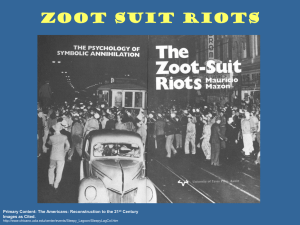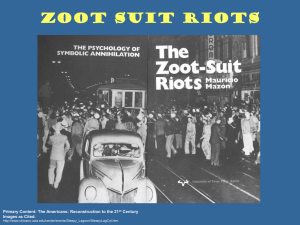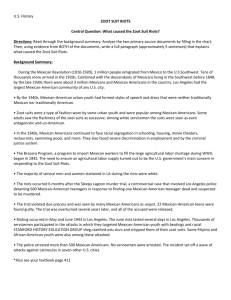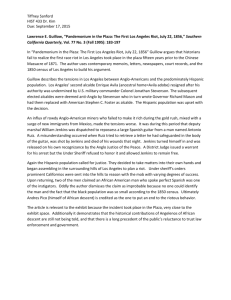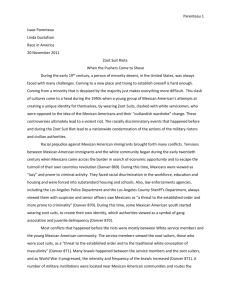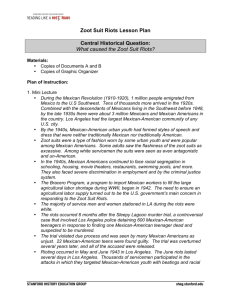Zoot Suit Riots: Photos, Timeline & News - Introductory Reader
advertisement
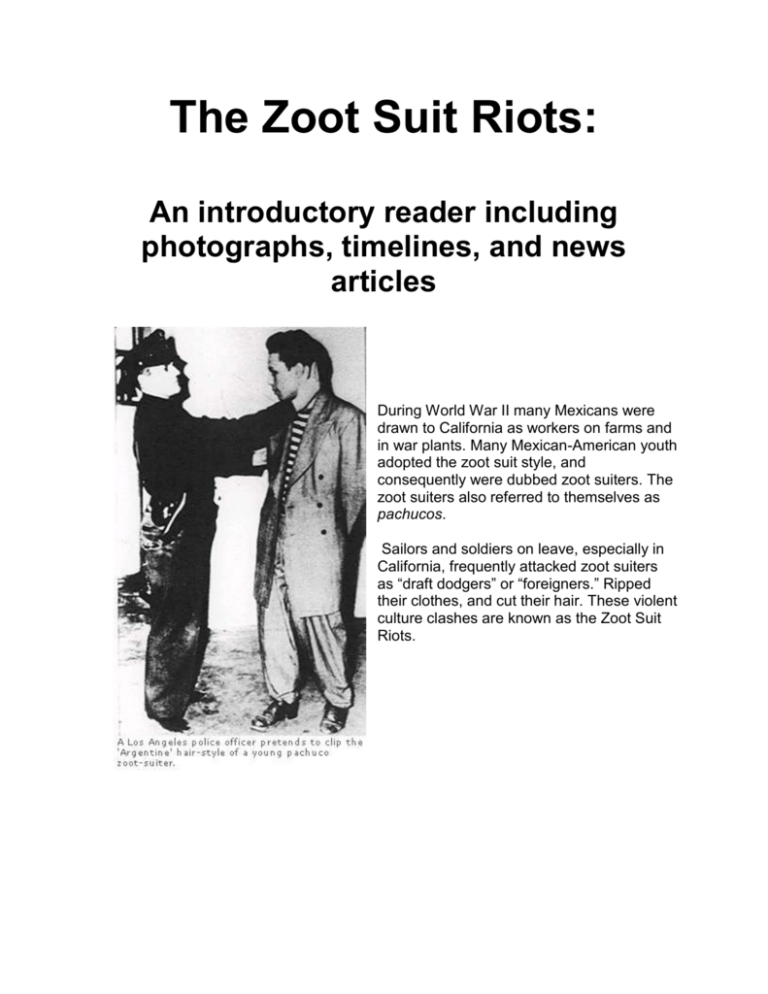
The Zoot Suit Riots: An introductory reader including photographs, timelines, and news articles During World War II many Mexicans were drawn to California as workers on farms and in war plants. Many Mexican-American youth adopted the zoot suit style, and consequently were dubbed zoot suiters. The zoot suiters also referred to themselves as pachucos. Sailors and soldiers on leave, especially in California, frequently attacked zoot suiters as “draft dodgers” or “foreigners.” Ripped their clothes, and cut their hair. These violent culture clashes are known as the Zoot Suit Riots. The Zoot-Suit Riots In the summer of 1943, Mexican American youth in Los Angeles faced discrimination and violence in their own neighborhoods at the hands of U.S. servicemen. ______________________________________________________________________________ World War II is often credited with pulling the country together. As their compatriots defended democracy abroad, however, some Americans met hostile forces on the home front. Los Angeles in the 1940s was swamped with GIs. The entertainment capital drew thousands of servicemen on leave from nearby bases and training centers. Like today, the civilian population of L.A. then included a large Mexican American, or Chicano, minority. Many of the white servicemen in town came from areas of the country where there weren't a lot of Chicanos. Here they heard stories about Chicano youth gangs and about how to pick up Chicanas, or Mexican women. A Chicano teenage fashion trend called the zoot suit -- modeled on flashy, mobster attire -- was widely ridiculed in the white press. Visiting servicemen joined in harassing "zoot-suiters." In the spring and summer of 1943, tension between GIs and young Mexican American males turned violent. In Oakland and Venice, Calif., sailors and marines "raided" Chicano gatherings and attacked the zoot-suiters, stripping them of their clothes. On June 3 in Los Angeles, a reported dispute over Chicanos set off a military riot. For five straight nights, Whites in uniform stormed the streets. They dragged zoot-suiters out of bars and nabbed them in movie theaters by turning the lights on. What started as an assault on Mexican Americans quickly expanded to include blacks and Filipinos. Each night, police officers waited until the GIs left and then swooped in to arrest the victims of the violence. Fearing mutiny, military officials declared the downtown district off limits to military personnel. The measure restored order, but real peace was harder to achieve. In a national newspaper column, first lady Eleanor Roosevelt blamed the riots on "long-standing discrimination against the Mexicans in the Southwest." A rebuttal by the Los Angeles Times ended with the statement, "We like the Mexicans and think they like us." This wording made clear, as far as official Los Angeles was concerned, Mexican Americans were still "them." TIMELINE: Zoot Suit Riots Spring: Clashes between servicemen and Mexican American youth occur up to two to three times per day. May: The Venice Riot. High school boys at the Aragon Ballroom complain that "Zoots" have taken over the beachfront. Soldiers appear at the ballroom claiming a sailor has been stabbed. An estimated crowd of 500 sailors and civilians attack Mexican American young people as they exit the dance. The fighting continues until 2:00 a.m. The police arrest Mexican American youth "for their own protection." May 31: Twelve sailors and soldiers clash violently with Mexican American boys near downtown. Seaman Second Class Joe Dacy Coleman, U.S.N., is badly wounded. June 3: Approximately 50 sailors leave the Naval Reserve Armory with concealed weapons to revenge the attack on Coleman. They target the neighborhoods near the Armory and attack anyone they can find wearing zoot suits -- giving birth to the name "Zoot Suit Riots". June 4: Rioting servicemen conduct "search and destroy" raids on Mexican Americans in the downtown area -- whether their victims are wearing zoot suits or not. The servicemen employ twenty taxis to look for zoot suiters. June 5: The rioting continues with attacks on all "pachuco"-looking males. A group of musicians leaving the Aztec Recording Company on Third and Main Streets are attacked. Attorney Manuel Ruíz and other Mexican American professionals meet with city officials. Carey McWilliams calls California Attorney General Robert Kenny to encourage Governor Earl Warren to appoint an investigatory commission. June 6: The rioting escalates and spreads into East Los Angeles. Kenny meets with McWilliams regarding the investigation and creates the McGucken Committee. Chaired by the Auxiliary Bishop of Los Angeles, Joseph T. McGucken, the committee blames the press for its irresponsible tone and the police for overreacting to the riot. June 7: The worst of the rioting violence occurs as soldiers, sailors, and marines from as far away as San Diego travel to Los Angeles to join in the fighting. Taxi drivers offer free rides to servicemen and civilians to the riot areas. Approximately 5,000 civilians and military men gather downtown. The riot spreads into the predominantly African American section of Watts. June 8: Senior military officials bring the riot under control by declaring Los Angeles off-limits to all sailors, soldiers, and marines. The Shore Patrol is under orders to arrest any disorderly personnel. The Los Angeles City Council passes a resolution banning the wearing of zoot suits in public, punishable by a 50-day jail term. June 9: Sporadic confrontations continue, but not at nearly the same intensity. June 18: An editorial in the Los Angeles Times reacts strongly to Eleanor Roosevelt's referring to the riot as a "race riot." “Crowds Downtown on Hunt for Zoot Suiters” Los Angeles Examiner June 8, 1943 ...As riot call after riot call was reported at police headquarters, the auxiliary police and motorcycle reserves were called out to help maintain order. Sirens sounded for hours as radio cars and patrol wagons raced to the scenes of reported riots. ...As the main element of the revenge-bent service men converged on downtown streets for the fourth night, they were joined -- for the first time in large numbers -- by civilians. From Main street they fanned out to comb through all possible haunts of pachucos.... Law enforcement officers did not attempt to stem the surging throngs. Occasionally, however, they stepped in to disarm anyone with a club or a weapon. ... At Twelfth and Central police were summoned after a melee developed between servicemen and pachucos. Five of the latter were arrested... At 10th and Los Angeles streets 20-year-old Edward Massey was taken in hand by 150 sailors and soldiers after he assertedly pilled a knife on a sailor. He was stripped of all clothing but his long coat... The United States Attorney's office in Los Angeles announced it was checking Federal laws to see whether action can be taken against anyone assaulting men in uniform. “Latin America Group Probes Street Fights: Fact-Finding Committee to Delve Into Causes of Brawls Between Servicemen, Gangs” Los Angeles Examiner June 8, 1943 Alarmed at the recent outbreak of street fights between so-called zoot suit gangs and men of the armed forces, the Citizens' Committee for Latin American Youth yesterday launched an extensive investigation of the situation and will report its findings to the press and public. ...The committee appointed several months ago by the supervisors to investigate relations among Latin Americans in Los Angeles County was told by various spokesmen for the Mexican community that only a small percentage of zoot suiters are trouble makers and that it is regrettable they should bring the entire Mexican population into ill repute... Nazis Spur Zoot Riots Los Angeles Daily News June 9, 1943 ...Sailors state that in fighting zoot suiters and other gangsters in Los Angeles they have only been avenging injuries inflicted on themselves and their wives in this area. A number of servicemen have been badly beaten by zoot suiters, and cases of attacks on wives of navy men have been reported. ...[A] telegram from the sailors said: "We make this plea in hopes that all fighting Americans are not in service, that there are some left to protect the families of ours. Our intent in taking justice in our own hands was not an attempt to instill mob rule but the only desire to insure our wives and families safe passage in the streets. "As none of the creators of the outrages on your wives and ours have been brought to justice or the streets made clean we felt that something had to be done. "Our past activities, we realize, were not within the law, but we are sure they met the honest approval of the people. "The so-called zoot suiters may now have free reign throughout our city of Los Angeles to do what they may with the wives of servicemen and civilians as they make their way home from swing and graveyard shifts in war plants. "The Los Angeles city limits are out of bounds to servicemen. We are not permitted to enter the city. "Has Los Angeles fallen to the zoot suiters? We are anxious to know. How about telling the folks at home for us?"
